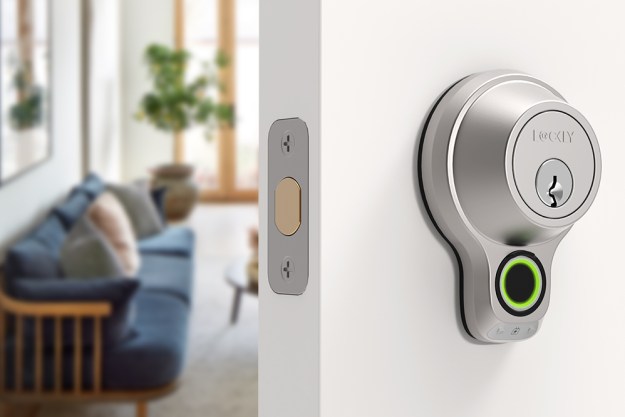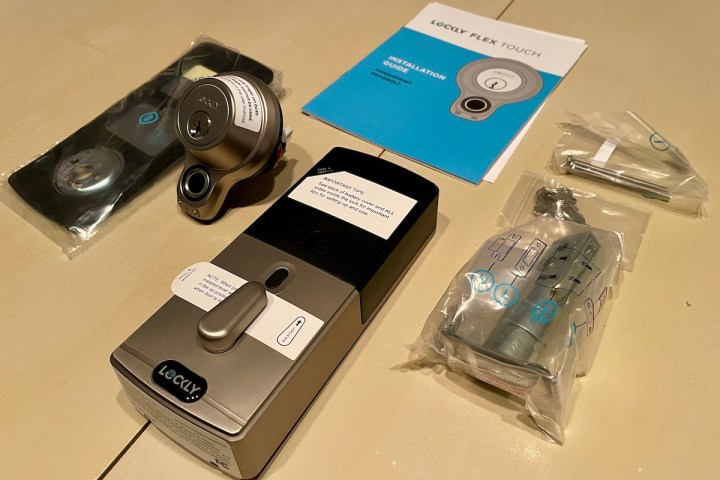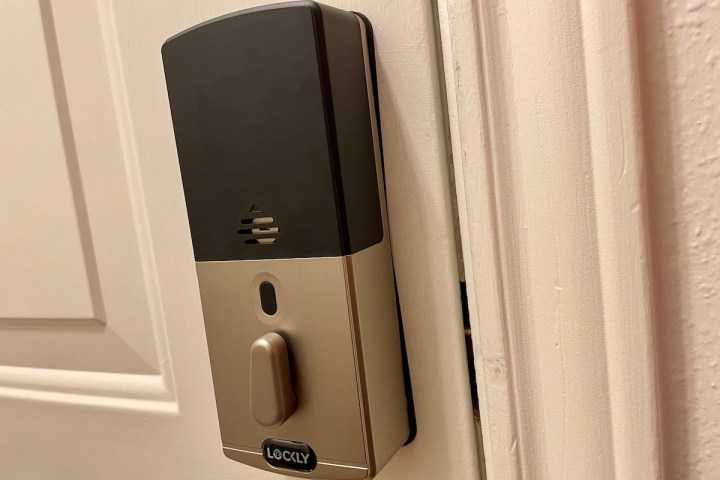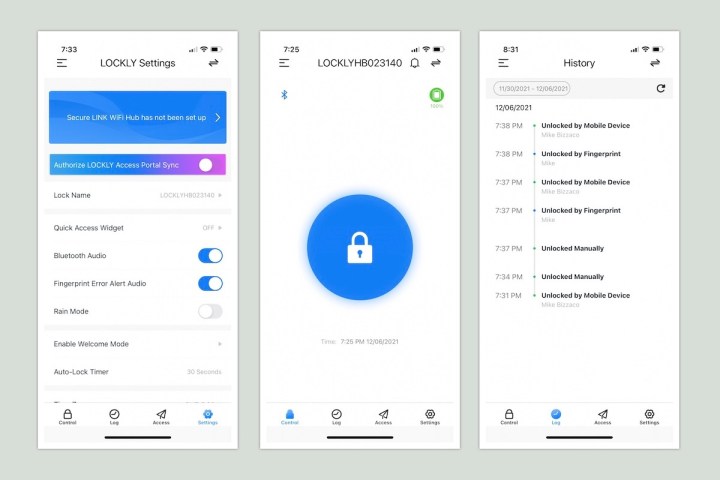
“The Lockly Flex Touch gives you plenty of ways to lock/unlock your doors and other customizations, but some may be turned away by the extra cost of adding Wi-Fi controls.”
- Quick and easy installation
- Responsive fingerprint scanner
- Multiple ways to lock/unlock
- Simple but efficient app
- Bulky interior design
- No rechargeable battery
- Requires Wi-Fi adapter for mobile features
Smart locks make up a distinct family of tried-and-true smart home devices. For the most part, these web-connected deadbolt peripherals have one job — keeping the door locked. The many bells and whistles, from fingerprint scanning to intuitive companion apps that offer a myriad of on-the-go controls, are secondary to the the certainty that the lock will protect your home every night.
You can find a dizzying amount of smart lock brands to choose from on brick-and-mortar and digital store shelves. Ideally, you’ll want to balance a solid brand name with a great set of security and control features. Oh, and a decent price never hurt either.
Lockly, a formidable name in the smart lock market, has produced a number of web-connected locks that we’ve installed and tested. The latest in the company’s lineup, the Lockly Flex Touch (available exclusively at Home Depot), does an excellent job of delivering a number of must-have smart lock features for less than $200. However, there are some other capabilities that the company didn’t include with the base package lock (more on that below).
Read on to learn more about our experience with the Lockly Flex Touch.
Out of the box

Unboxing the Lockly Flex Touch, you’ll find everything you need for installation. This includes the exterior and interior lock peripherals (the latter with attached wire harness), deadbolt assembly, a mounting harness and strike plate, screws for all components, and a user manual. The lock should also be packaged with an Activation Code Card featuring your Flex Touch’s serial and activation code.
The code will be required during setup, and if you ever need to pair or replace your lock, you’ll need the unique PIN again. Keep the card in a safe place after setup.
The biometric fingerprint scanner is one of the best we’ve ever worked with.
Our first impressions on the overall look and feel of the lock were pretty good. The exterior-facing, satin-nickel key cylinder is durable but sleek. In fact, aside from the fingerprint reader, the lock exterior looks like most traditional single cylinder locks you’ll find.
What we were less impressed by is the interior assembly. It’s big, at least compared to most interior smart lock hardware. At seven inches tall and close to four inches wide, the chassis is framed to accommodate the four AA batteries needed to power the Flex Touch. Let’s just say it doesn’t exactly blend in with most doors.
Simple installation, quick setup

Getting the Flex Touch in place and powered up was a fairly straightforward process.
To get things started, you’ll first need to remove your existing lock and deadbolt. Similar to other smart locks, Lockly’s included deadbolt assembly is built for both 60mm and 70mm configurations, depending on the kind of door you’re working with. My door required a deadbolt adjustment, which was as simple as twisting the bolt body clockwise. You’ll both feel and hear an

Once the deadbolt is screwed in, it’s just a matter of attaching the exterior lock and feeding the connection cable through, securing the interior mount plate, plugging the cable in, and then screwing the interior assembly into place. Oh, and don’t forget to throw in the four AA batteries. The Flex Touch is supposed to come with them, although mine didn’t. So before installing, it might be wise to make sure you have some extra batteries on hand.
Before you slap on the battery cover, you’ll need to hold down the Program button before inserting the last of your four AA batteries. A series of chimes will let you know that the lock is calibrating to your door. Once the calibration is finished, you can go ahead and download the Lockly companion app (for iOS and
Ensure your phone or tablet’s Bluetooth is toggled on, as this is how your Flex Touch is going to be controlled by your mobile device (more on that below). After being prompted to enter your lock’s unique activation code, the general setup is complete. All said and done, you’re probably looking at about half an hour (tops) for installation.
Key features

With most smart locks hovering around $200, the Flex Touch is priced a bit lower than average, but don’t expect cheaper pricing to translate to less tech. While Lockly did lock a number of the Flex Touch’s mobile controls behind the Lockly Secure Link Wi-Fi Hub paywall, the base features of the Flex Touch are pretty great.
The Lockly app has a simple layout and a number of easy-to-access settings.
For starters, the biometric fingerprint scanner is one of the best we’ve ever worked with. In contrast to more sensitive fingerprint smart locks that can become finicky when it’s raining or cold outside, the Flex Touch’s print reader took a solid scan of my app-mapped finger each time, locking and unlocking with next to no holdups.
In fact, the only time I had any trouble was after returning home from a long, frigid walk. The print scanner faulted my first reading, but a simple rescan was all it needed. It’s also nice to know that the lock can store up to 99 individual fingerprints, for cases where your dominant hand is otherwise occupied or you want someone else to unlock the door.
Other key features include a reliable Auto Lock function, physical backup keys, and external 9V battery contacts if the AA batteries run dead, as well as quick and simple profile duplication to import your fingerprints and eKey passes to other Lockly smart locks.
Mobile controls and the Lockly app
One of the most convenient aspects of any smart lock is the ability to remotely lock/unlock your doors while you’re on the go. Remote access is especially great when you’re en route to the house in a car loaded with groceries. Instead of fumbling for keys or having to decide which finger to scan while balancing bags on both shoulders, you can simply open your lock app (after parking in the driveway, of course) and tap a button to unlock the door.
Yes, mobile controls are available for the Lockly Flex Touch. No, these features are not included out of the box. If you want remote lock/unlocking, multidoor locking, Alexa and
This means a fully outfitted Flex Touch will cost you around $230. Not bad, but there are numerous smart locks that include Wi-Fi controls out of the box, and sometimes for less than $200. Without the network module, the Flex Touch and Lockly companion app run off of Bluetooth, which means you’ll still be able to lock/unlock from the app, just as long as you’re close to the lock itself.
The Lockly app has a simple layout and a number of easy-to-access settings. The home page lists the rooms of your home(s) and whatever Lockly devices are mapped to them. Selecting the Flex Touch, you’ll be taken to the lock’s status and control screen. A big, blue lock/unlock button takes up a majority of the real estate, with Control, Log, Access, and additional Settings located at the bottom of the page. There’s also a battery life readout in the top-right corner.
Mapping fingerprints is handled through the Lockly app, and the process is a cinch. Once you tap Start, you’ll press your finger to the scanner repeatedly, lifting it when you hear a beep. Once the scanning is finished, the print is logged in the Lockly app. You can map multiple fingers across multiple users, and the lock administrator can input prints to as many Lockly devices as you want.

You can also use the app to monitor when and how (fingerprint, app, key) the Flex Touch was unlocked, adjust haptics and sounds for the lock and app, and add/remove users to your Lockly account.
Pricing and warranty
Right now, you’ll only find the Lockly Flex Touch at Home Depot stores and online at homedepot.com. The current selling price is $150 and the lock comes with both a limited five-year mechanical warranty, as well as a two-year electronics warranty.
Don’t forget: If you want to control the lock with
Our take
In our opinion, the Lockly Flex Touch is a great “starter” smart lock. It’s a perfect gift for someone that’s just getting into the world of smart home tech. The install is simple, the app is solid, and there are plenty of Bluetooth-only features to enjoy. After a while though, you may find yourself wanting more.
When and if you reach that point, you can either invest in the Secure Link for additional features, or maybe relegate the Flex Touch to another door and invest in a new smart lock altogether.
Is there a better alternative?
Yes, especially if you want a smart lock that’s Wi-Fi-ready out of the box. One of our favorite smart locks, the August Wi-Fi Smart Lock, normally sells for around $230, doesn’t require a Wi-Fi bridge, and is packed with incredible features and tons of app customizations.
If budget is important, there’s also the Wyze Lock. Priced around $130, it’s quick to install, the app is great, and like the August lock, there’s no need for a Wi-Fi bridge.
How long will it last?
Based on the generous mechanical warranty period (five years), we’re guessing the Lockly Flex Touch will last for a long time. Do keep in mind that there’s no rechargeable lithium ion pack here, so you’ll need to stay on top of the battery life of the four AA batteries.
Lockly claims you’ll get about a year of use out of the first round of batteries, but to be on the safe side, you may want to try replacing them every six to eight months.
Should you buy it?
That depends. If you want a low-priced smart lock and don’t mind Bluetooth-only controls to start with, the Lockly Flex Touch is a solid bet, especially when you consider the responsive fingerprint reader. If Wi-Fi is integral, though, you can easily snag a network-ready smart lock for only a few dollars more than the Flex Touch’s $150 asking price.
Editors' Recommendations
- Lockly smart lock adds voice controls, fingerprint sensor to existing deadbolts
- IKEA’s new air purifier is a design masterpiece that won’t break the bank
- A tap of your finger or NFC card conveniently unlocks the Level Touch smart lock
- Eufy Security Smart Lock offers bank-grade security for the home





